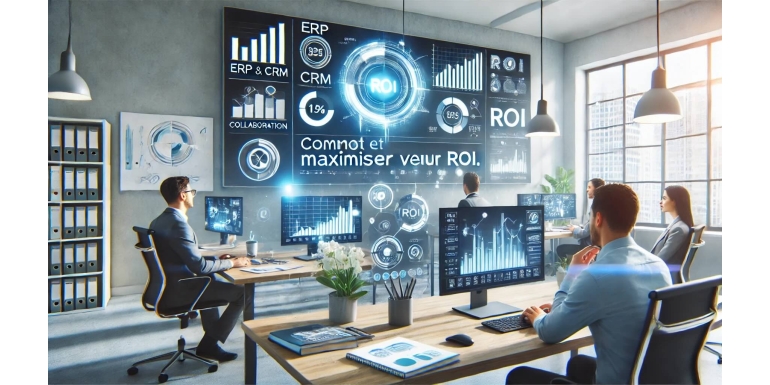
The integration of ERP (Enterprise Resource Planning) and CRM (Customer Relationship Management) systems has become essential for businesses looking to enhance operational efficiency and profitability. By combining these two powerful tools, organizations can maximize their return on investment (ROI) while optimizing internal processes and improving customer relationships. This article will explore in detail how the integration of ERP and CRM can transform your business and the best practices to get the most out of it.
Understanding ERP and CRM
What is an ERP?
An ERP system is designed to manage and integrate a company’s core functions, including finance, human resources, supply chain, and production management. By centralizing data into a single system, ERPs provide comprehensive visibility into operations, making it easier to make informed decisions.
What is a CRM?
A CRM, on the other hand, focuses on managing customer interactions. It helps businesses track customer information, manage sales, marketing, and customer service. An effective CRM allows for personalized interactions with customers, increasing loyalty and enhancing the customer experience.
Why is Integrating ERP and CRM Crucial?
1. Unified Data View
One of the primary benefits of integrating an ERP with a CRM is the creation of a unified data view. This means that all information related to customers, sales, and operations is accessible from a single location. This visibility enables teams to collaborate more effectively and make decisions based on accurate data.
2. Improved Operational Efficiency
Integrating these two systems helps businesses eliminate redundancies and automate processes. For example, customer order information can be automatically updated in the ERP system after a sale, reducing the risk of errors and speeding up order processing.
3. Enhanced Customer Experience
With a better understanding of customer needs and behaviors, businesses can personalize their offerings and communications. A CRM integrated with an ERP allows for customer segmentation and tailored marketing campaigns, improving engagement and increasing conversion rates.
4. Better Inventory Management
The integration of ERP and CRM systems enables more effective inventory management. Sales teams can see real-time product availability, helping them avoid lost sales due to stockouts. Additionally, sales forecasts based on CRM data can assist in more accurate production and supply planning.
How to Maximize Your ROI Through ERP-CRM Integration
1. Assess Needs and Goals
Before integrating your ERP and CRM systems, it is essential to assess your specific needs and define your goals. What are the main pain points you currently face? What results do you want to achieve? A clear understanding of your objectives will help you choose the right tools and implement an effective integration strategy.
2. Choose the Right Systems
There are many ERP and CRM systems available on the market, each with its own features and benefits. It is important to select systems that integrate easily and can scale with your business. Look for solutions that offer robust APIs and native integration capabilities.
3. Training and User Adoption
The success of ERP-CRM integration largely depends on user buy-in. Invest in training your staff to understand how to use the integrated systems effectively. Create resources, guides, and training sessions to help your teams adapt to the new technologies.
4. Process Automation
Leverage automation to streamline your operations. Automate workflows between the CRM and ERP to reduce manual tasks and minimize errors. For instance, lead data can be automatically transferred to the ERP for order processing, speeding up the sales cycle.
5. Data Analysis for Informed Decisions
ERP-CRM integration allows for advanced analytics and reporting. Use this information to make data-driven decisions. Analyze sales trends, customer behaviors, and marketing campaign performance to adjust your strategies accordingly.
6. Continuous Improvement
Integrating ERP and CRM systems should not be a one-time project but a process of continuous improvement. Regularly evaluate your processes, identify areas for enhancement, and adjust your systems as necessary. Technology evolves rapidly, and it is essential to stay updated with the latest trends and innovations.
Case Studies: Successful ERP-CRM Integration
Case Study 1: Distribution Company
A distribution company decided to integrate its ERP system with its CRM to improve operational efficiency. Before integration, the sales teams spent a lot of time manually checking stock levels. After integration, inventory information was updated in real-time, allowing sales representatives to process orders faster and increase sales by 20% within a year.
Case Study 2: Service Company
A service company integrated its CRM with its ERP to better track ongoing projects and customer interactions. This integration allowed the company to improve customer satisfaction by providing accurate updates and anticipating customer needs. As a result, customer retention increased by 30%.
Challenges of ERP-CRM Integration
1. Initial Costs
Integrating an ERP and a CRM can require a significant initial investment. It is crucial to consider this cost in your ROI evaluation. Think about the potential long-term savings from increased efficiency and better resource management.
2. Complexity of Integration
Integrating two systems can be complex, especially if one is not designed to work with the other. Ensure you have the necessary resources, whether internal experts or external consultants, to facilitate this transition.
3. Resistance to Change
Resistance to change is a reality in any technological transformation. Clearly communicate the benefits of ERP-CRM integration to your teams and involve them in the process to minimize resistance.
Conclusion
Integrating ERP and CRM systems is an effective way to maximize your company's return on investment. By creating a unified view of data, improving operational efficiency, and personalizing customer experiences, you can transform your internal processes and increase profitability. By following best practices for integration, you will be able to leverage these powerful tools and remain competitive in the market.
